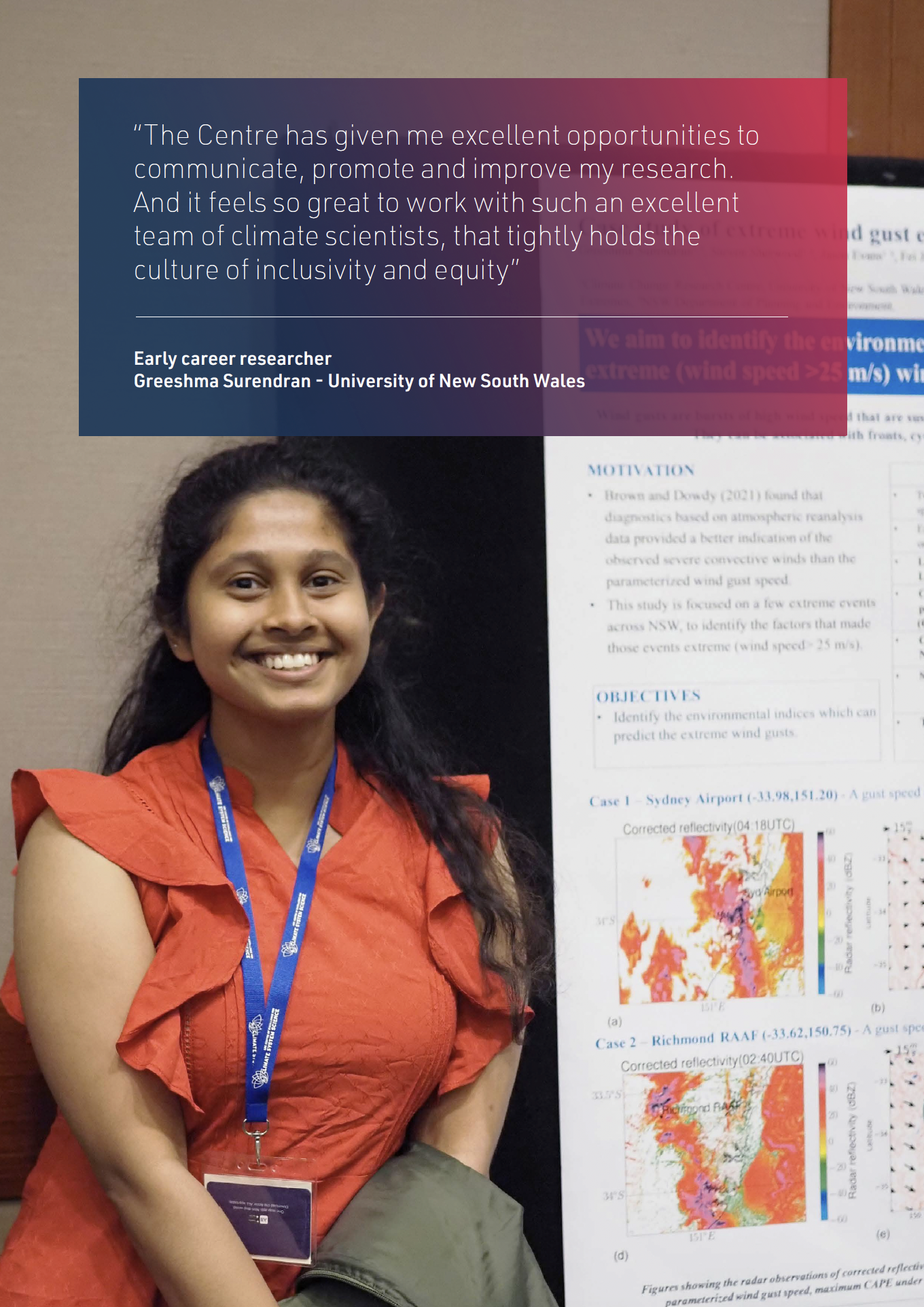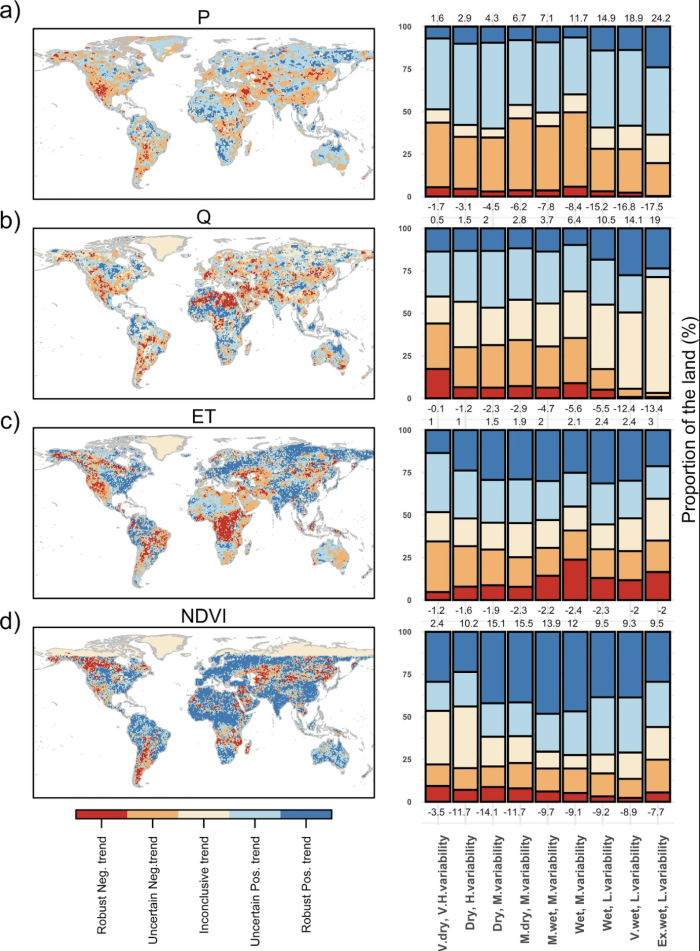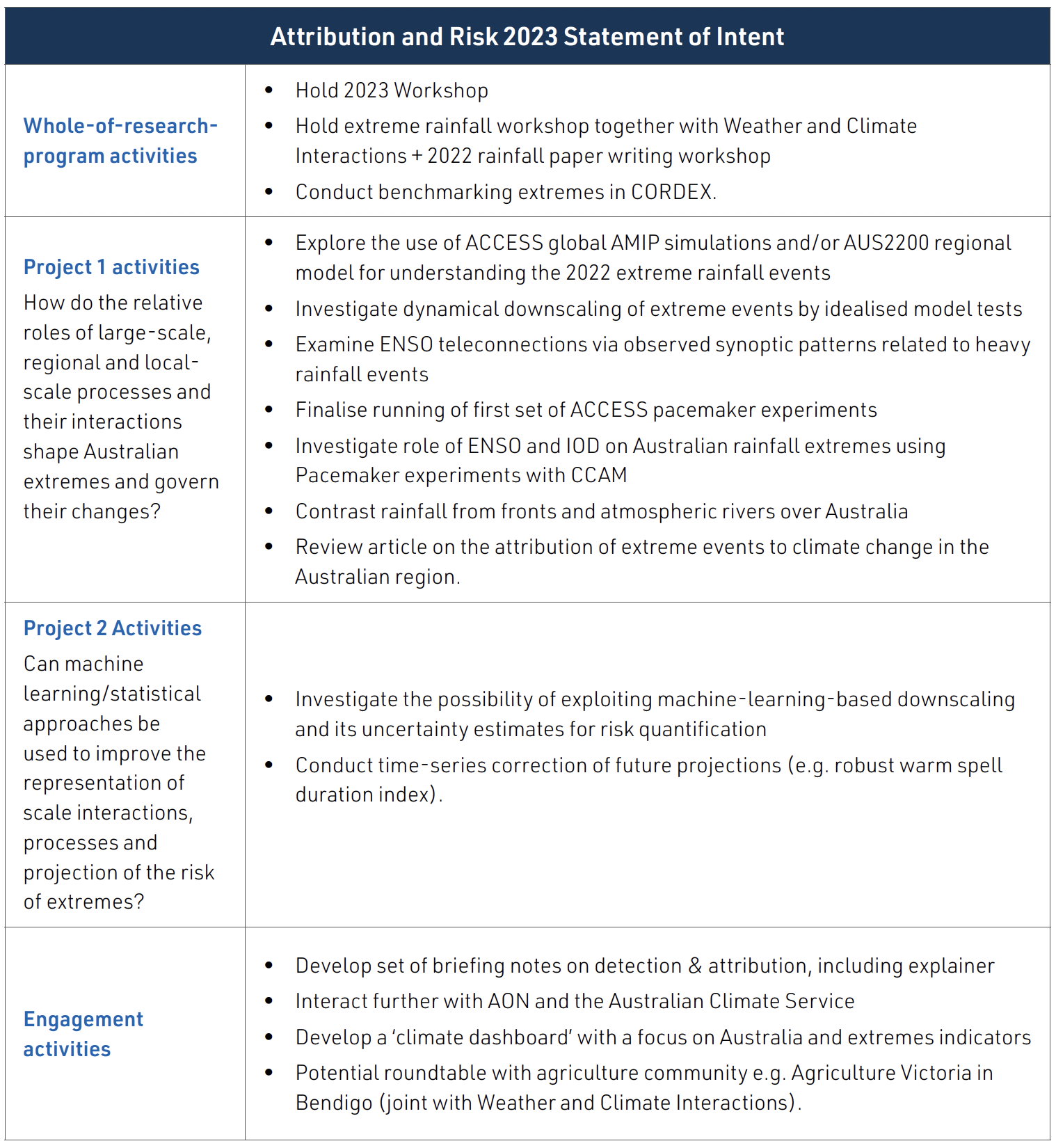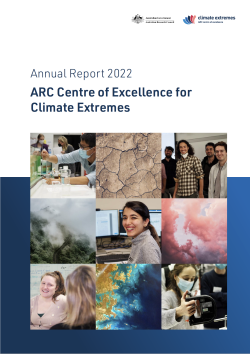The Attribution and Risk research program had a busy start to the year, organising and participating in a number of seminars and meetings around the February and March extreme rainfall events in Queensland and NSW and associated floods. This included substantial outreach through media interviews and briefing notes on extreme rainfall, atmospheric rivers, compound events and the triple-dip La Niña, as well as contributions to the 2022 NSW Flood Inquiry. The extent to which climate change played a role in these events was a frequent question and we plan to extend our work on these extraordinary extremes throughout 2023, with a number of workshops, model simulations and research articles planned.
ARC Centre of Excellence for Climate Extremes postdoctoral researchers, Yawen Shao and Zoe Gillett, coordinated regular monthly meetings of the research program throughout the year, including speakers from industry (for example, Valentina Koschatzky from Risk Frontiers on catastrophe modelling), Partner Organisations (for example, John Fasullo from the National Center for Atmospheric Research on the climate impacts of the Australian bushfires) as well as research updates from across the Centre of Excellence community.
We continued to build relationships with industry, through webinars and discussions with the agriculture, adaptation and finance sectors. Our researchers also returned to international travel for the first time since 2019, contributing and presenting our research at forums such as the International Symposium on Data Assimilation, Stratospheric-Tropospheric Processes and their Role in Climate General Assembly and the World Meteorological Organization-United Nations Environment Programme’s Scientific Assessment of Ozone Depletion Panel final review meeting, as well as others, both in-person and virtually.
PROJECT 1
How do the relative roles of large-scale, regional and local-scale processes and their interactions shape Australian extremes and govern their changes?
Extremes in temperature and rainfall often occur during excursions of tropical Indian and Pacific variability; for example, La Niña. This was evident in 2022, which saw a rare triple-dip La Niña and a wetter-than-average year across most of Australia, particularly in the south-east.
However, the mechanisms of these interactions between the tropics and extratropics – and between processes at different scales – are not fully understood. In a paper published in the Journal of Atmospheric Sciences, Dr Zoe Gillett and co-authors used a novel modelling framework to simulate the time-evolving response to a sudden switch-on of heating in the tropical Indian Ocean. It revealed a new pathway for Rossby wave propagation below the subtropical jet stream, which is prominent across subtropical latitudes of Australia in winter and has long been recognised to act as a barrier to the propagation of Rossby waves, which are important for teleconnections to south-eastern Australia. These results have implications for forecasting the Australian climate response to the Indian Ocean Dipole, as it relies on a good simulation of the subtropical jet. To explore the impacts of tropical variability on Australian extremes further, Dr Gillett has been coordinating pacemaker experiments with the Australian Community Climate and Earth System Simulator–Coupled Model 2 (ACCESS-CM2) as part of an international coordinated tropical basin interaction project.
Other studies explored the fidelity of extremes in models and observations, including a study led by Dr Nidhi Nishant which examined the impact of spatial resolution on means and extremes in precipitation. They compared precipitation in high-resolution dynamically downscaled data against the driving lower-resolution reanalysis over Australia, finding that high-resolution data were less accurate than lower-resolution data for standard statistics of precipitation. They also showed that the extra detail resolved by higher resolution is of negligible importance compared to the overall uncertainties. These results highlighted that increasing the horizontal resolution alone may not help address problems with precipitation. Significant model developments and data assimilation techniques are also required to reap the benefits of high horizontal resolution.
PROJECT 2
Can machine learning/statistical approaches be used to improve the representation of scale interactions, processes and projection of the risk of extremes?
We continued to make substantial progress in the application of advanced statistics and machine-learning techniques in 2022.
Focusing more on the risk component of Attribution and Risk, Associate Investigator Dr Tim Raupach developed and published an improved hail proxy for Australia, which predicts whether an atmospheric environment is prone to hailstorm formation. This proxy has been applied to reanalysis data and will form a basis for upcoming work on machine-learning-based techniques for characterising local-scale hailstorm environments. Separately, Centre of Excellence for Climate Extremes Masters student Isabelle Greco is leading the development of a Bayesian model to explore links between radar hail detection, reports of hailstorms and population density, with the goal of producing a probabilistic hail climatology for Australia.
Centre PhD student Rachael Isphording is leading work on developing a standardised benchmarking framework to assess the veracity of rainfall simulations from regional climate models. The framework, which will allow for the standardised intercomparison of statistics and precipitation processes across any downscaled simulation, has so far been applied to CORDEX-Australasia output. The framework has been built to be flexible so that it can be applied to simulations from any region and, once finalised, will be able to assess the ‘added value’ of any given regional precipitation simulation. The ultimate goal is to help stakeholders better utilise ensemble projections from a variety of different sources.
Postdoctoral researcher Dr Yawen Shao and Chief Investigator Professor Craig Bishop have continued to make important refinements to their new, multiplicative correction approach, in order to create a set of CMIP-based projections that have much more realistic variances across a range of time scales. Further, by applying ensemble weighting, they can more accurately project and attribute climate extremes such as heatwaves.

RESEARCH SNAPSHOT

A critical question in hydrology is the extent to which climate change is affecting changes in rainfall, evapotranspiration and runoff over land and how this might impact human activity. We demonstrate that more than 50 percent of the land surface has experienced robust changes in these hydrological cycle components since 1980. Of particular concern is increasing water-resource stresses in key breadbasket regions, including in Australia, and in some densely populated areas. Using a diverse range of observations, in combination with data assimilation approaches and machine learning, our results support the general conclusion that over land “wet gets wetter but dry does not get drier”.
Hobeichi, S., Abramowitz, G., Ukkola, A.M., De Kauwe, M., Pitman, A., Evans, J.P., Beck, H., 2022. Reconciling historical changes in the hydrological cycle over land. npj Clim Atmos Sci 5, 17. https://doi.org/10.1038/s41612-022-00240-y
RESEARCH SNAPSHOT
Time of emergence is a concept showing when the trend in a climate variable emerges above the “noise” of natural climate variability. A study led by Centre of Excellence PhD student Xu (Pete) Deng used large ensembles of the latest state-of-the-art climate models and a range of future scenarios to understand this concept for temperature extremes over Australia. The strongest warming levels, and therefore earlier time of emergence, are projected under the highest future scenario, with tropical Australia usually showing the highest warming. However, emergence patterns differ greatly for different extreme indices and there is large inter-model uncertainty in time of emergence, with internally generated variations influencing the noise.
Deng, X., Perkins-Kirkpatrick, S.E., Alexander, L.V., Stark, C., 2022. Projected changes and time of emergence of temperature extremes over Australia in CMIP5 and CMIP6. Earth’s Future 10, e2021EF002645. https://doi.org/10.1029/2021EF002645
RESEARCH SNAPSHOT
Atmospheric rivers are narrow regions of strong moisture transport in the lower atmosphere. They can cause beneficial rainfall – on average, atmospheric rivers contribute 20 to 35 percent of south-east Australia’s and 10 to 20 percent of south-west Australia’s annual rainfall. However, they can also be disastrous, with 20 to 30 percent of the heaviest rainfall days in the northern Murray-Darling Basin occurring during atmospheric rivers – including the devastating February-March floods in 2022. That year, Dr Kim Reid and co-authors published the first study to quantify the effects of atmospheric rivers over all of Australia. Current Centre of Excellence research is exploring how we can better predict these systems and their future behaviour.
Reid, K.J., King, A.D., Lane, T.P., Hudson, D., 2022. Tropical, subtropical and extratropical atmospheric rivers in the Australian region. Journal of Climate 35, 2697–2708. https://doi.org/10.1175/JCLI-D-21-0606.1

ARC Centre of Excellence for Climate Extremes – Annual Report 2023
From the Chair of the Advisory Board
Climate Science Leaders of the Future
Weather and Climate Interactions Research Program
Attribution and Risk Research Program
Ocean Extremes Research Program
Computational Modelling Systems
Governance, Management and our Commitment to Equity, Diversity and Inclusion

